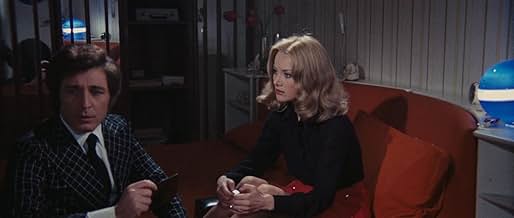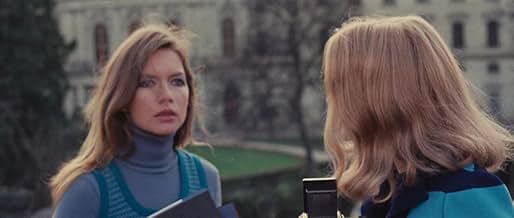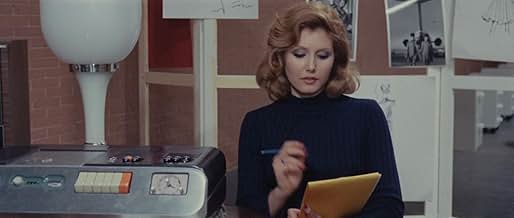Füge eine Handlung in deiner Sprache hinzuTwo sisters inherit their family castle, which is said to be haunted by their ancestor: a raven-haired, red-robed woman who is said to commit seven murders every hundred years.Two sisters inherit their family castle, which is said to be haunted by their ancestor: a raven-haired, red-robed woman who is said to commit seven murders every hundred years.Two sisters inherit their family castle, which is said to be haunted by their ancestor: a raven-haired, red-robed woman who is said to commit seven murders every hundred years.
- Rosemary Müller
- (as Maria Pia Giancaro)
- Tobias Wildenbrück
- (as Rudolf Schindler)
- Policeman
- (Nicht genannt)
- Leonora Roiburg
- (Nicht genannt)
- Policeman
- (Nicht genannt)
- Springe Management Member
- (Nicht genannt)
- Plainclothes Police Agent
- (Nicht genannt)
- Springe's Department Director
- (Nicht genannt)
Empfohlene Bewertungen
Directed by Emilio P. Miraglia who, one year earlier, also made the very interesting "La Notte che Evelyn Usci della Tomba" (see also my comment on that one), the film starts off a little slow, but all in all, no time is wasted with unnecessary sub plots or sequences.
This film is a German-Italian coproduction, but it was released in Germany on video only in a version trimmed by 15 minutes of plot under the stupid title "Horror House". At least the murder scenes, which will satisfy every gorehound, are fully intact, and the viewer still gets the killer's motive at the end. But the Italian version containing all the footage is still the one to look for, of course.
A convincing Giallo with obligatory twists and red herrings, "La Dama Rossa Uccide Sette Volte" is highly recommended to Giallo fans and slightly superior to Miraglia's above mentioned other thriller.
Later on, their grandfather tells them the legend related to the picture hanging on the wall in front of them, in which a lady dressed in black is stabbing a lady dressed in red:
"A long time ago, a red lady and a black lady lived in the same castle. They were sisters and hated each other. One night, for jealousy reasons, the black lady entered the red lady's room and stabbed her seven times. One year later, the red lady left her grave. She killed six innocent people, and her seventh victim was the black lady. Once every hundred years, the events repeat themselves in this castle and a red lady kills six innocent victims before killing the black lady herself."
The grandfather ends his tale by saying that according to the legend, sixteen years from now, the red queen should come again and kill seven times. But he assures them that this is just an old legend.
Sixteen years pass.....
This is the very beginning of the film. There are many twists and surprises in the film. It's better for you to forget about logic (if you really analyse it, the story doesn't make sense) and just follow the film with its wonderful colors, the gorgeous women, the clothes, the tasteful decor, the lighting effects and the beautiful soundtrack.
Enjoy Barbara Bouchet, Sybil Danning, Marina Malfatti, Pia Giancaro, among other goddesses. There's a nude by Sybil Danning lying on a sofa that's something to dream about. And don't forget: The lady in red kills seven times!
If you've liked "La Dama Rossa..." check out also "La Notte che Evelyn uscì dalla Tomba".
This was Emilio Miraglia's follow-up to "The Night Evelyn Came Out of the Grave". Barbara Bouchet stars, making 1972 a good year for her -- she was also in the highly praised Fulci film "Don't Torture a Duckling". With her is "Evelyn" holdover Marina Malfatti who was also having a god year -- she was in Sergio Martino's "All the Colors of the Dark". Supporting them is Marino Masé, who appeared in even bigger films -- "The Leopard" and "Nightmare Castle", to name a couple. Lastly, Sybil Danning has a smaller early role here -- today (2016) she is probably the best-known of the cast due to her transition into American films.
Composer Bruno Nicolai, another holdover from "Evelyn", really ties the film together. He had done many, many films but I would say this is probably among his best work. Unfortunately, aside from "Caligula", he never seems to have risen above Italian B-movies, even if he was in the same league talent-wise as Ennio Morricone.
Luca Palmerini, no fan of Miraglia, dismisses this film as "mediocre". While it may not be groundbreaking or on the level of the masters (Fulci, Bava, Argento), for me, an average giallo is better than most horror films any day of the week. There is just something about the style and use of color that remains unmatched in American movies. And Palmerini fails to notice the striking villain (one of the most memorable of the giallo genre) and the clever blend of giallo and Gothic that seems to be the defining trait of Miraglia.
Arrow Video hired both Alan Jones and Kim Newman to provide an audio commentary for their masterful blu-ray disc. The two tag team the commentary expertly, and either could have done it alone. But together? It is incredible.
The second and last effort of Emilio Miraglia after the brilliant Gothic "The Night Evelyn Came Out of the Grave," "The Red Queen Kills Seven Times" is a rather similar effort, but with slight modifications in both plot and tone. Where "Evelyn" treaded supernatural Gothic territory, "Red Queen" is a bit more of a heavy-handed giallo that is shamelessly over-plotted and also far more violent. Evoking the kind of giallos that Argento or Bava made in the 1970s, the film really takes its time working up elaborate murders and a faceless killer.
Tonally, it is slightly different from Miraglia's preceding film in that it was shot exclusively in Germany, and very much has a Bavarian aesthetic, featuring a German-European castle setting, rolling forests, and small mountain villages as backdrops. It is an atmospheric film, and in Miraglia's fashion, is oriented toward the Gothic.
As I mentioned, the film is a bit zany in terms of plot, and throws curveball after curveball without pause, so it is a film that demands its audience's attention in order to make sense of what is happening on screen. Barbara Bouchet and Marina Malfatti (returning from Miraglia's previous film) have the lead roles, and are both very good. The finale is fantastically elaborate and the final reveal is thematically quite dark; there is an especially memorable scene set in a flooding underground chamber that really deserves some respect.
Overall, "The Red Queen Kills Seven Times" is a solid effort, and does a fantastic job at juggling elements of the giallo with that of the Gothic thriller. It is a far less supernaturally-oriented film than Miraglia's "Evelyn," and it is also more extensively plotted. The unabashed twists and turns do become a bit redundant and exhausting along the way, but the finale is a nice payoff to an otherwise atmospheric thriller. The killer's red cloak (perhaps a foresight for "Don't Look Now"?) and menacing cackle are also not to be dismissed. 7/10.
Wusstest du schon
- WissenswertesThough the film was co-produced by a West German production company and mostly shot in West Germany, it was never released theatrically there. Instead, it premiered straight to home video in the late 1980s.
- PatzerWhen Kitty knocks Eveline against the stone base of the obelisk, presumably knocking her out, no blood is shed. Cut to the body in the water, and it is instantly surrounded by a ring of blood.
- Zitate
Martin Hoffmann: I already have enough women.
Lulu Palm: Sure, a wife in a psychiatric hospital, and that other one, Kitty. I bet when you go to bed, you don't make love, you just talk about it.
Martin Hoffmann: And if I like to talk about love?
- Alternative VersionenAmerican release was cut in the violence to ensure a "PG" rating.
- VerbindungenFeatured in Rocknacht des Grauens (1980)
Top-Auswahl
- How long is The Red Queen Kills Seven Times?Powered by Alexa
Details
- Erscheinungsdatum
- Herkunftsländer
- Sprache
- Auch bekannt als
- Die rote Dame
- Drehorte
- Produktionsfirmen
- Weitere beteiligte Unternehmen bei IMDbPro anzeigen
- Laufzeit1 Stunde 39 Minuten
- Sound-Mix
- Seitenverhältnis
- 2.35 : 1
Zu dieser Seite beitragen




























